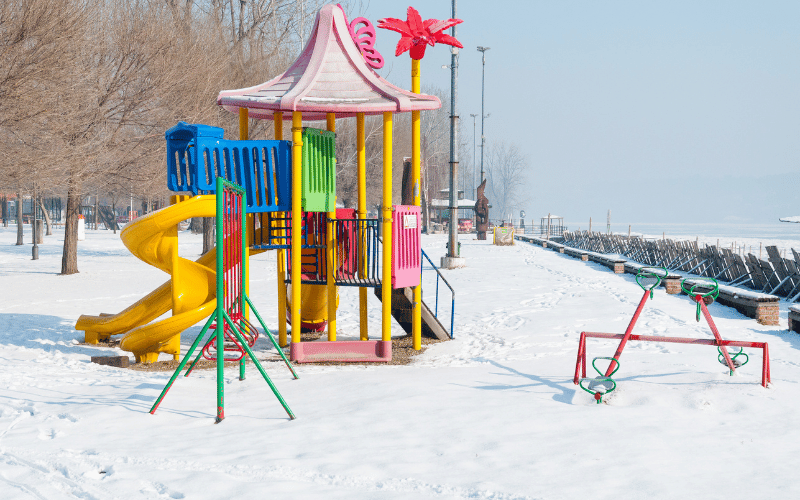Winter can be tough on playgrounds, but proper preparation makes all the difference. Many playground owners worry about damage from snow, ice, and freezing temperatures. I’ve worked with countless clients who want to protect their investment while ensuring their playgrounds remain safe and durable. Winter maintenance doesn’t have to be overwhelming. With the right steps, you can prevent costly repairs, keep children safe, and extend the lifespan of your equipment.
Playground surfaces, structures, and hardware face unique challenges during winter. Freezing and thawing cycles can crack rubber surfacing, rust metal components, and weaken wood structures. Snow and ice create slippery hazards, while compacted loose-fill materials lose their cushioning effect. These issues can lead to safety risks and expensive repairs if left unaddressed.
This guide walks you through everything you need to know about winterizing your playground. You’ll find step-by-step tips for pre-winter inspections, cleaning, and protective measures. I’ll also cover essential winter maintenance practices, like snow removal and ongoing inspections, to keep your playground safe throughout the season. Finally, I’ll show you how to prepare for a smooth post-winter reopening, ensuring your playground is ready for springtime fun. Let’s get started!
Table of Contents
TogglePre-Winter Inspection and Cleaning
Preparing your playground for winter starts with a thorough inspection and cleaning. These steps ensure your equipment remains safe, functional, and ready to withstand the harsh conditions of the colder months.
Inspecting Playground Components
Begin by walking through your playground with a critical eye, as if you’re the equipment’s personal caretaker. Check for wear and tear, such as loose bolts, damaged parts, splintered wood, or rusted metal. Pay close attention to high-traffic areas like swings, slides, and climbing structures, as these endure the most stress. Use a wrench to tighten any loose hardware and replace worn-out components immediately to prevent further damage.
Look for potential hazards like cracks in plastic slides, sharp edges on metal parts, or frayed ropes. These issues can worsen in freezing temperatures, making them even more dangerous. Address these problems now to avoid costly repairs or safety risks later.
Deep Cleaning
A deep cleaning session is essential before winter sets in. Start by removing debris, leaves, and dirt from all surfaces, including play structures, pathways, and surrounding areas. Use a soft-bristle brush or a pressure washer on low settings to clean hard-to-reach spots. This step prevents mold, mildew, and grime from accumulating during the damp winter months.
Sanitize all surfaces, especially those frequently touched by children, such as handrails, slides, and climbing grips. Use a child-safe disinfectant to maintain hygiene and reduce the risk of germs lingering through the season.
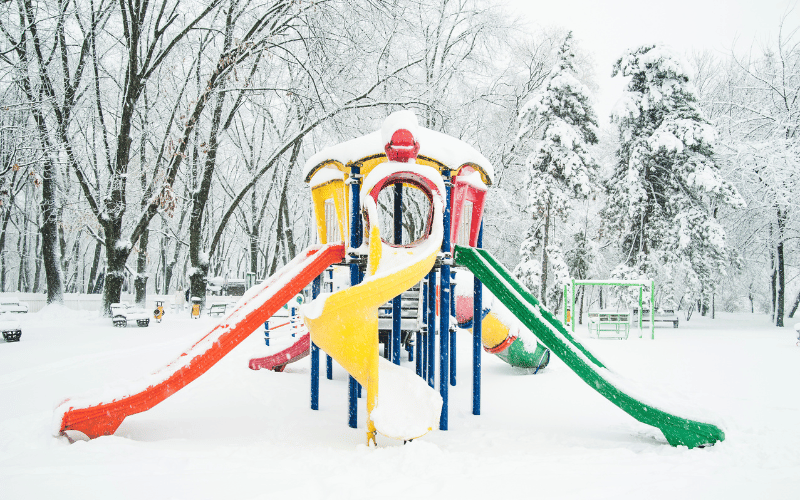
Addressing Drainage Issues
Water is your playground’s worst enemy during winter, as it can freeze and cause ice buildup, leading to slippery surfaces and structural damage. Inspect the area for drainage issues, such as clogged gutters, pooling water, or uneven ground. Clear out any blockages in drainage systems and ensure water runoff flows away from play areas.
If you notice persistent pooling, consider adding gravel or regrading the area to improve drainage. Taking these steps now will help prevent ice hazards and protect your equipment from water-related damage.
Protecting Playground Surfaces and Structures
Winter can be harsh on playground surfaces and structures, but with the right care, you can shield them from damage and ensure they’re ready for action when spring arrives. Each material requires specific attention, and securing movable parts is just as critical to maintaining the integrity of your playground.
Material-Specific Care
Metal Components:
Metal parts are like the backbone of your playground—they’re strong but vulnerable to rust if left unprotected. Apply a rust prevention coating to all exposed metal surfaces, paying special attention to joints and connection points where moisture tends to accumulate. Use a wire brush to remove any existing rust before applying the coating. For added protection, consider sealing joints with weatherproof tape or silicone to block out water.
Plastic Slides and Panels:
Plastic components may seem low-maintenance, but winter can take a toll on them. Use a UV protectant spray to prevent fading and brittleness caused by sun exposure, even during colder months. Inspect slides and panels for cracks or weak spots, as freezing temperatures can worsen these issues. Repair small cracks with a plastic repair kit to prevent them from spreading.
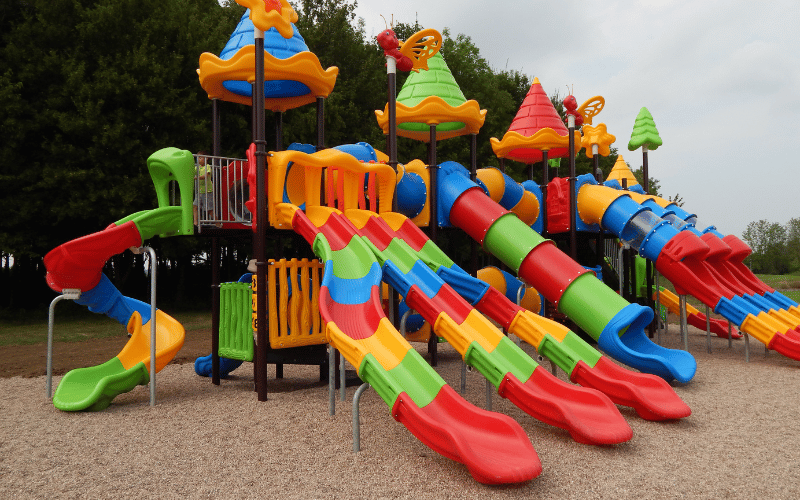
Wood Structures:
Wood structures bring warmth and charm to a playground, but they need extra care to withstand winter. Apply a high-quality wood sealant to protect against moisture and rot. Focus on areas where water tends to pool, such as the bases of posts or horizontal surfaces. If you notice splintering or cracks, sand them down and apply a wood treatment to reinforce the material.
Rubber Surfacing:
Rubber surfacing is durable, but it’s not immune to winter’s challenges. Inspect the surface for cracks or gaps that could expand in freezing temperatures. Clean the rubber thoroughly to remove dirt and debris, which can trap moisture and lead to mold or mildew. If you find any damage, patch it with a rubber repair kit to maintain a safe and even surface.
Securing Movable Parts
Movable parts like swings, chains, and loose accessories are particularly vulnerable during winter storms. Remove swings and other detachable components, and store them in a dry, indoor space to prevent rust and wear. For parts that can’t be removed, secure them tightly with weather-resistant straps or covers to minimize movement and reduce the risk of damage.
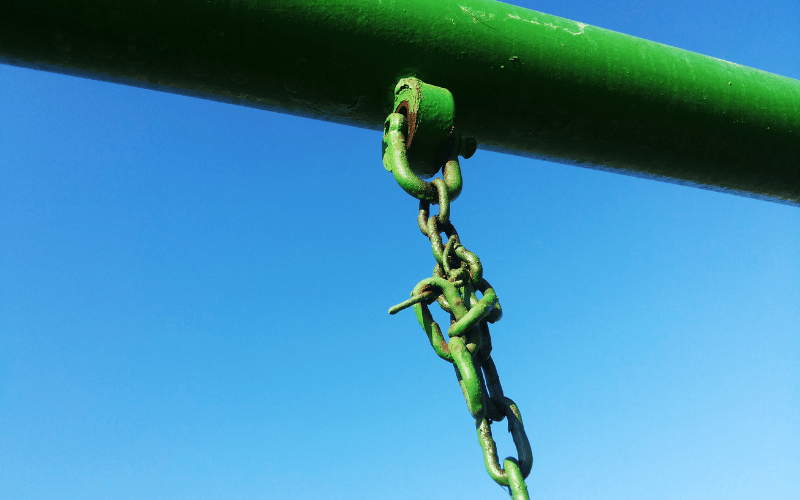
By giving each material and component the care it needs, you can protect your playground from winter’s harsh effects and ensure it remains a safe and inviting space for years to come.
Winter Maintenance and Safety Tips
Winter doesn’t mean your playground has to hibernate, but it does require extra care to keep it safe and functional. By managing snow and ice, conducting regular inspections, and implementing safety precautions, you can ensure your playground weathers the season without compromising on safety or quality.
Snow and Ice Management
Snow and ice are inevitable during winter, but how you handle them can make all the difference. Use non-abrasive tools, such as plastic shovels or soft-bristle brooms, to remove snow from surfaces without scratching or damaging them. Avoid using metal shovels, as they can gouge rubber surfacing or chip paint on metal components.
When it comes to ice, steer clear of salt or harsh chemicals, which can degrade materials like rubber, plastic, and wood. Instead, opt for child-safe alternatives like sand or pet-friendly ice melt to improve traction without causing long-term damage. Focus on high-traffic areas, such as pathways and entry points, to ensure they remain safe and accessible.
Ongoing Inspections
Winter’s freeze-thaw cycles can wreak havoc on playground equipment, so regular inspections are essential. Check for new damage caused by freezing temperatures, such as cracks in plastic, splintering wood, or rust on metal components. Pay close attention to joints, bolts, and other connection points, as these areas are particularly vulnerable to stress from temperature fluctuations.
Ice hazards can form quickly, especially in shaded or low-lying areas. Inspect high-traffic zones like slides, swings, and climbing structures for slippery spots, and address them immediately to prevent accidents. Keep a log of your inspections to track recurring issues and ensure nothing gets overlooked.
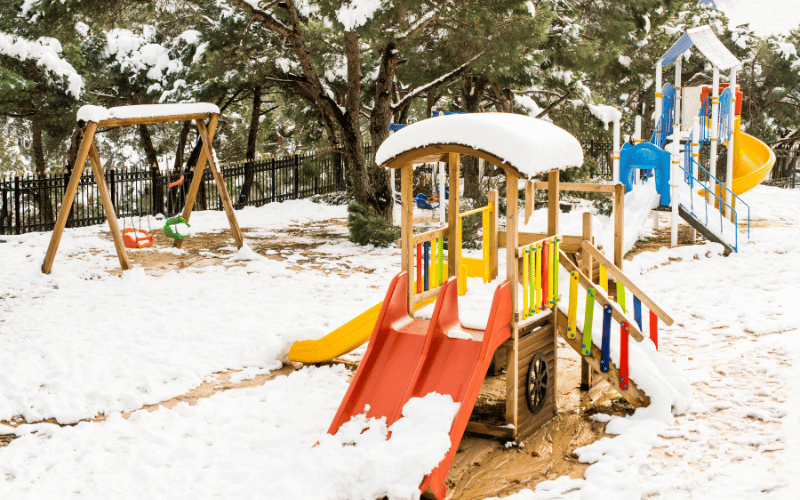
Safety Precautions for Winter Use
If your playground remains open during winter, safety precautions become even more critical. Encourage parents to dress children appropriately for the season, including gloves, boots, and warm layers. Proper footwear with good traction can help prevent slips and falls on icy surfaces.
Supervision is non-negotiable during winter play. Train staff or volunteers to monitor children closely, especially on equipment that may become slippery or brittle in cold weather. Consider posting clear signage to remind visitors of winter-specific rules, such as avoiding wet or icy slides and using caution on climbing structures.
By staying proactive with maintenance and safety measures, you can keep your playground safe and enjoyable throughout the winter months, ensuring it remains a trusted space for families year-round.
Post-Winter Reopening and Repairs
As winter fades and warmer days approach, your playground needs a little TLC to bounce back from the cold season. A thorough cleaning, careful inspection, and timely repairs will ensure your equipment is safe, inviting, and ready for action.
Spring Cleaning
Start your post-winter reopening with a deep clean to remove the grime that winter left behind. Use a pressure washer on low settings or a soft-bristle brush with mild soap to clean all surfaces, including slides, swings, and climbing structures. Pay special attention to areas where dirt and debris tend to accumulate, such as corners, joints, and under platforms.
Sanitize high-touch surfaces like handrails, climbing grips, and play panels to maintain hygiene. For playgrounds with loose-fill surfacing, such as wood chips or rubber mulch, rake and redistribute the material to even out high-traffic areas. Replenish the surfacing as needed to maintain the recommended depth for fall protection—typically 9-12 inches, depending on the material.
Inspecting and Repairing Damage
Winter can leave its mark on playground equipment, so a detailed inspection is crucial. Look for cracks in plastic slides, breaks in wooden structures, or rust on metal components. Use a flashlight to check hidden areas, such as the undersides of platforms or inside tube slides, where damage might not be immediately visible.
Address any issues promptly. For example, replace cracked plastic panels, sand down splintered wood, and apply rust remover to corroded metal. Tighten loose bolts and replace any missing hardware to ensure the equipment remains stable and secure. If you encounter significant damage, consult with a professional repair service to avoid compromising safety.
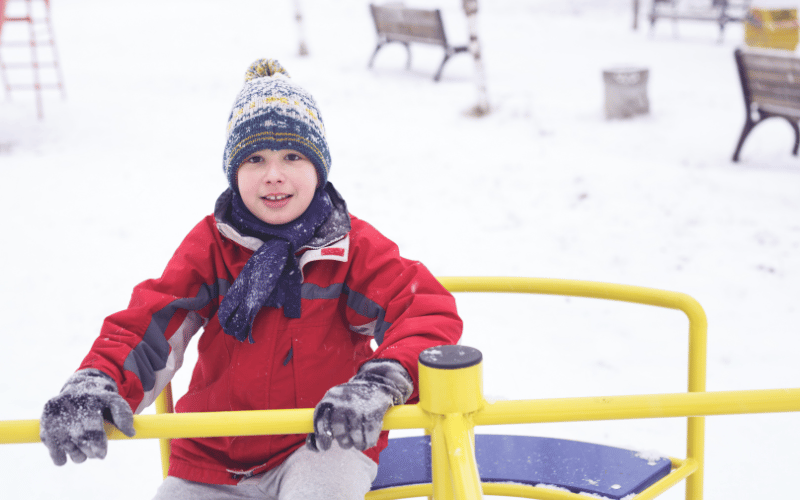
Reapplying Protective Coatings
Protective coatings are your playground’s armor, and they need refreshing after a long winter. Reapply UV protectants to plastic components to prevent fading and brittleness under the spring sun. For metal parts, use a rust inhibitor to shield against moisture and extend their lifespan.
Wood structures require special attention—apply a fresh coat of wood sealant to protect against water damage and rot. Focus on areas that experience the most wear, such as handrails, steps, and the bases of posts. By reapplying these coatings, you’ll not only enhance the appearance of your playground but also ensure it’s ready to withstand the elements for another season.
By tackling these post-winter tasks with care and precision, you’ll set the stage for a safe and enjoyable playground experience that families can count on.
FAQs
Q: How often should I inspect my playground in winter?
A: Inspect your playground at least once a week during winter, especially after heavy snow, ice, or windstorms. Regular checks help you catch issues like ice buildup, cracks, or loose hardware before they become safety hazards. Increase the frequency of inspections if your playground remains open for use during the colder months.
Q: What cleaning products are safe for playground equipment?
A: Use mild, non-toxic cleaning products specifically designed for outdoor surfaces. Look for biodegradable cleaners that are safe for children and the environment. Avoid harsh chemicals like bleach or ammonia, as they can damage materials such as plastic, rubber, and wood. For sanitizing, choose child-safe disinfectants approved for playground use.
Q: Can swings and movable parts stay out during winter?
A: It’s best to remove swings and other movable parts during winter to prevent damage from freezing temperatures and harsh weather. Store them in a dry, indoor space to protect against rust and wear. If removal isn’t possible, secure them tightly with weather-resistant straps and cover them with durable, waterproof tarps.
Q: How do I prevent rust on metal playground parts in cold weather?
A: Apply a rust prevention coating or inhibitor to all metal components before winter begins. Focus on joints, bolts, and other areas prone to moisture accumulation. Regularly inspect metal parts for signs of rust, and address small spots immediately with rust remover and touch-up paint to prevent further corrosion.
Q: What is the safest way to remove ice from playground surfaces?
A: Use sand or pet-safe ice melt to improve traction on icy surfaces without damaging materials. Avoid using salt or traditional ice melt, as they can degrade rubber, plastic, and wood. For physical removal, use non-abrasive tools like plastic shovels or soft-bristle brooms to avoid scratching or chipping the surfaces.
Conclusion
Winterizing playgrounds plays a vital role in ensuring safety, extending the lifespan of equipment, and saving on costly repairs. Take proactive steps now to protect your playground by addressing potential hazards, maintaining surfaces, and preparing for seasonal challenges. Start by scheduling regular inspections, creating a maintenance plan, or consulting with professionals to ensure your playground remains safe and ready for use year-round.




